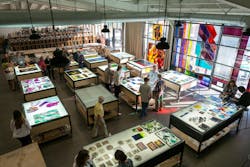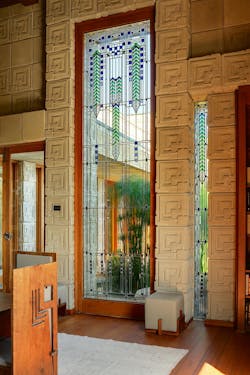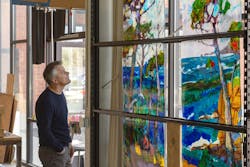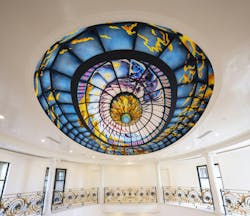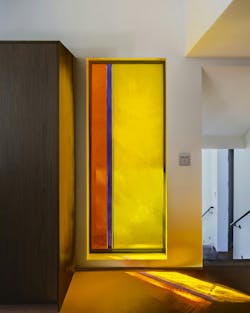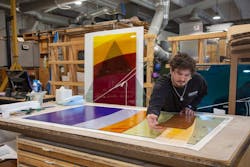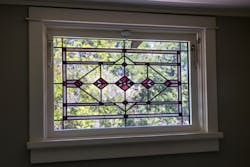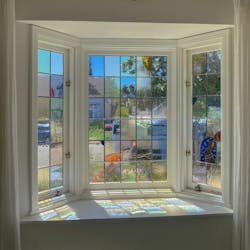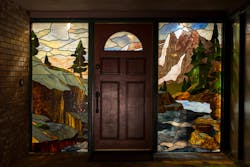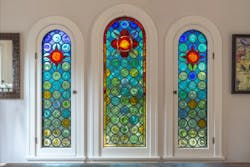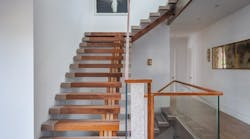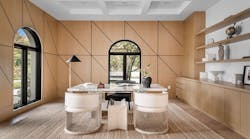The 127-Year-Old Studio Reviving Stained Glass for Modern Homes
- Judson Studios balances historic stained-glass craft with innovative glass fusing to meet modern design demands.
- The studio's high-end residential work is growing, driven by interior designers seeking functional, artistic glass installations.
- In-house design and installation ensure quality control, overcoming challenges unique to residential stained-glass projects.
Welcome to our "Made to Order" series, where we spotlight artisans and innovators behind the products that make their way into custom builds. Read our earlier profile of architectural concrete fabricator Concretti Designs.
For decades, stained glass has been "boxed in" by preconceptions of old church windows and Victorian relics. But at America's oldest family-owned stained-glass studio, fifth-generation owner David Judson is shattering those assumptions by literally fusing different colored glasses in kilns to create contemporary compositions that are redefining the ancient craft for luxury homes.
There's something about your physical space that's grounding when you have things that are made by hand.
While Judson Studios still takes on the institutional commissions that have sustained it for over a century, its portfolio has long included landmark residential work, like the geometric stained-glass windows it created for Frank Lloyd Wright’s iconic Ennis House.
Today, residential projects are gaining momentum again. “We're seeing that high-end residential market is growing more for us,” Judson says.
Now, a third of the studio’s work comes from private homes and commercial projects, a dramatic shift from its church-focused origins.
The shift isn't just aesthetic, Judson says. He sees it as a response to our age of AI and digital overload, with luxury homeowners seeking something tangible.
"There's something about your physical space that's grounding when you have things that are made by hand," Judson says, drawing parallels to the Arts & Crafts movement that emerged as a response to the effects of the Industrial Revolution.
Interior designers, once hesitant about stained glass's traditional associations, are now driving much of this demand. "I don't remember working with designers as much as we do now, both for residential and hospitality," says Judson.
And those designers are using custom glass installations strategically, not just for decoration, but to solve real architectural challenges. They appreciate glass as a "great problem solver" that introduces color, creates unique screens between spaces, and provides elegant filtering solutions. Think privacy screens, room dividers, or pocket doors that filter light while maintaining openness.
What's making this residential expansion possible is Judson's dual mastery of both traditional stained-glass techniques and his pioneering adoption of glass fusing. While the studio continues to excel at classic lead-came construction—the centuries-old method of joining glass pieces with lead strips—fusing represents the innovation that's opening new creative possibilities.
This newer technique allows artisans to melt different colored glasses together in kilns, creating seamless color transitions impossible with traditional methods.
Working with renowned artist Narcissus Quagliata, Judson became the first major stained-glass studio to embrace fusing for large-scale projects, transforming what was once dismissed as a "hobbyist thing" into a sophisticated design tool.
"If you think about an Impressionist or abstract painting, fusing is much more adapted to that," Judson explains. While the technique opens doors to abstract applications, it maintains traditional craftsmanship principles. "Those fundamental principles of the traditional stained glass still apply no matter what we do."
For builders and their design partners, this represents an opportunity to offer clients something genuinely distinct: handcrafted artistry that transforms spaces while honoring centuries of tradition.
Judson Studios takes on projects from small repairs to multi-million-dollar commissions, with residential work typically priced between $400 and $1,500 per square foot. Installations usually take 10 to 12 weeks after design approval.
Their 27-person team manages two to three dozen jobs simultaneously, handling everything in-house—from design through installation—to maintain quality and control.
Every project begins with understanding the space and client needs, usually involving homeowners and designers.
“Architects aren’t quite sold on stained glass yet,” Judson notes.
Factors like window orientation and light exposure guide design and material choices.
Design is creative but requires technical precision. “Your design is one thing, but making it is another,” Judson notes, explaining that windows will fail if details get overlooked. The studio uses digital tools for design refinement and shop drawings, then selects materials—machine-made or mouth-blown glass—based on budget and style.
Installation is the most delicate phase. “No one wants to touch stained glass,” Judson says. To avoid damage and ensure proper fit, especially since most residential frames aren’t built for stained glass, the studio handles installation themselves.
Despite assumptions about declining interest in traditional crafts, Judson reports "a lot of young people" interested in working with glass. "Most of our people are fairly young now," he notes, describing a mix of 20-somethings working alongside 30 to 40-year veterans. "I think this new young generation is interested in working with their hands and with materials," Judson explains.
Keeping that energy going, he says, means nurturing that interest. "You've got to create that environment to a certain extent too. I feel like I've really tried to do that where it's an interesting place for these people to try things and keep it fresh."
This workforce renaissance is creating a unique dynamic where traditional techniques are being preserved while innovation flourishes.
The studio operates with what Judson describes as "very different cultures" between traditional stained glass and fusing techniques, requiring careful integration of knowledge systems. Master craftspeople who've spent decades perfecting lead-came construction are now learning to work with kilns and glass compatibility, while younger artisans trained in fusing must understand the structural principles that have sustained stained glass for centuries.
"The basics are really important," Judson emphasizes. "Small things like how you cut glass, which tools you use, how you can cut certain cuts, and others you can't. The thickness of things, the durability or the pliability. It's the very small details."
Understanding these fundamentals becomes the foundation for innovation, ensuring that new approaches don't compromise structural integrity or longevity—whether the final piece uses traditional or contemporary methods.
Today's residential clients reflect this evolution in their aesthetic preferences, gravitating toward "pale tints and earthy tones," a departure from the saturated colors traditionally associated with religious installations.
This shift reflects broader design trends toward natural, calming palettes that complement contemporary architecture.
When clients commission artistic rather than decorative pieces, the results become deeply personal. "We see things that people love doing like sailing, pets, landscapes, or images that have a very personal connection,” says Judson. “We interpret those for people in private spaces."
For builders and designers seeking differentiation in luxury markets, this craft renaissance represents something increasingly rare: authentic human artistry that creates meaningful connections with spaces.
"Things we have in our homes mean something to us," Judson notes, highlighting how custom stained glass creates personal connections impossible with mass-produced elements.
The question for forward-thinking builders isn't whether handcrafted elements will find their place in luxury construction, but how quickly they can integrate these timeless techniques into contemporary practice.
As Judson demonstrates, the future of stained glass lies not in abandoning tradition, but in applying traditional principles to solve modern challenges, creating spaces that honor the past while embracing the future.
Related Reads
About the Author
Pauline Hammerbeck
Pauline Hammerbeck is the editor of Custom Builder, the leading business media brand for custom builders and their architectural and design partners. She also serves as a senior editor for Pro Builder, where she directs products coverage and the brand's MVP Product Awards. With experience across the built environment - in architecture, real estate, retail, and design - Pauline brings a broad perspective to her work. Reach her at [email protected].
